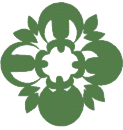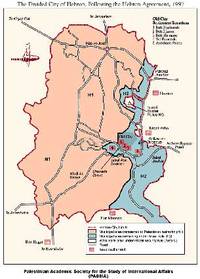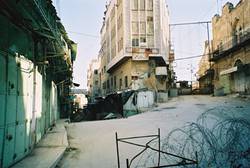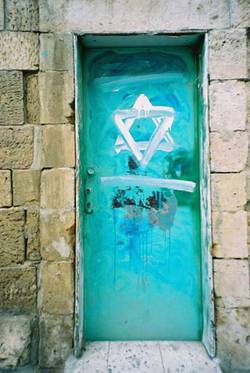Menu


- Map of Hebron
WLOE Reports from Israel and Palestine
A Women and Life on Earth report from Hebron, from a member who volunteered in 2002-2003 with organizations in Israel and Palestine dedicated to ending the Israeli Occupation and working towards a just and viable solution to the conflict through non-violent protest, media campaigns, and human rights advocacy.
: Part of my work in Israel and the Palestinian Territories entails networking with other NGO's and grass-roots organizations, visiting them at their home offices, and experiencing the situation they face "on the ground". Through my work I had come into contact with a youth organization in Al Khalil (Hebron in English) called the International Palestinian Youth League. Their organization is instrumental in coordinating international volunteer work camps in the Territories and in providing vocational training for Palestinian youth. I am hoping that through them I can learn more about the unique and volatile situation in the West Bank city of Al Khalil.
Jane*, a friend and fellow activist, and I make it from Jerusalem to Al Khalil (approx. 35-40 km) in just under an hour and a half, with only one side-of-the-road security stop and no checkpoints. It takes one, short detour off the main highway and we are in the city.
Al Khalil proper is a patchwork of rolling hills and valleys dotted with three-story stone buildings. It has a fairly modern appearance, full of small factories, workshops, and retail stores. Despite being a industrialized city, it still has houses with modest-sized gardens and vineyards with goats roaming the slopes of their land. The sights and smells of Al Khalil are overwhelming. Hundreds of people stream along the streets and sidewalks, children coming home from school, women shopping, men transporting goods, friends calling out to one another, and taxi drivers honking to push through the late-afternoon muddle of traffic. Occasionally amidst the traffic we see older men riding their donkeys. Nearing the center, we see that the streets leading into the old city are blocked off by chunks of concrete, which seem to cause most of the traffic chaos. As we search for the entrance to the old city, we notice that passageways filled with beautiful 800 year-old stone buildings have also been blocked off and made into Israeli checkpoints. The Palestinian stores and homes around these checkpoints are completely closed up and the streets are empty. We decide to try and pass the checkpoint and after a brief security check we are allowed through. The street on the other side is also void of all signs of life and we soon see tell-tale signs that the formerly Palestinian controlled streets had been expropriated by the Israeli settlement. What was until recently part of the Palestinian old city of Al Khalil was now tagged with Israeli flags and posters in Hebrew; the Star of David was spray-painted over a few of the green iron doors.
A Brief History of the Israeli Settlements in Al Khalil
Palestinian and Jewish people have a long history of living together side by side in Al Khalil. Today, the difference in their relationship to one another lies primarily in the Israeli politics of using settlers and settlements for power and control. Despite it being illegal and in violation of international agreements, Israeli settlers began the process of expropriating land in Al Khalil in 1968, one year after Israel occupied the entire West Bank. Al Khalil was of particular interest to many Zionist settlers as the Tomb of Abraham is located there.
In the city of Al Khalil there are approximately 140,000 Palestinians and 450 Israeli settlers. The city is divided into two parts: H1 is under the "control" of the Palestinians and H2 is the Israeli controlled area. It is the only Palestinian city in the West Bank were Israeli settlements have taken over land within a Palestinian city, in effect forcing settlers and Palestinians to live in direct proximity to one another.
The presence of the settlers and the intense security around their settlements has significantly impacted the economy in Al Khalil. Subject to the whims of random security measures, the historically prosperous economy has been sharply reduced as it is next to impossible to maintain businesses and the flow of goods into the city under the curfews, lock-downs, security closures, and the spontaneous checkpoints that have become common place in the Palestinian parts of the city. These security measures, meant to keep the two peoples apart and safe, have only led to a system of control and power for the settlers in Al Khalil. For any "security reason", the entire city can be collectively punished and forced to stay indoors, at times for 24 hours straight and for days on end. The Israeli settlers, who exclusively use the elaborate system of Israeli-only by-pass highways in and out of the city, have often expressed their preference of enjoying Al Khalil during curfew while the city streets are free of its Arab residents. The settlers, referring to "Hebron" as an Israeli city with a majority of Arabs, have had a violent and brutal history with the Palestinian people in the area. The most publicized attack occurred on February 25, 1994, when a group of armed settlers led by an American immigrant, Benjamin Goldstein, massacred more than 50 Palestinian men and boys and injured over 100 others during their prayer at the Ibrahimi Mosque. The massacre was met only with international condemnation.
Although heated and often bloody clashes occur regularly, Ariel Sharon and his government continue to openly encourage and give generous financial support to Israeli settlement growth in Al Khalil.
18 November: The Search for Handala The next day, Jubran*, a Palestinian volunteer with IPYL, offers us a tour of Al Khalil in his beat-up BMW. There has been little tension in the city in the past few weeks because of Ramadan, Jubran explains as we wind down steep passageways into the old city. Even if it has been quiet, Jane and I can't help but notice the young, heavily armed Israeli soldiers patrolling the streets of H1. But our attention quickly drifts away from soldiers to our main goal for the day. We are searching for the famous Handala, the icon of the Palestinian refugee's struggle for human rights, dignity, and the right to live in their native land. Handala is a figure of a refugee child, created by famed Palestinian cartoonist Naji Al Ali, who stands with his back to people as a rejection of all imperialist regimes. Handala was forced from his home in Palestine at the age of ten, the same age his creator was forced to leave his village in 1948. The myth of Handala says that he will always remain ten years old, refusing to grow older until he is able to return to his home. "Handala" means bitterness in Arabic.
We start looking for signs of the barefoot and tattered boy in Al Khalil's numerous jewelry and tourist shops without success. Finally, in a gift shop, we spot three Muslim teenage girls who have hand-carved wooden Handala key chains. Jubran asks one of the girls where she bought it and she proudly replies, "Dura" the name of her village. The shop keeper, realizing our interest, pulls out a black tray with two small, silver Handala pendants. Holding the small figure in my hand, it becomes clear why Handala is a source of pride and a symbol of solemn resistance for many Palestinians. I stare at the simply drawn caricature, the patchy hair, the small cartoon hands held behind his back, taking in the defiant nature of its design. I wonder if this occupation will ever end, if the settlers will ever leave, and if there will ever be a time when the Palestinian refugees will be able to return home. Will Handala remain ten forever, watching the destruction taking place on Palestinian land? With the teenage girls watching and giggling shyly behind us, we purchase the pendants, wave goodbye and enter again into the flurry of activity on the streets of Al Khalil.
Jubran tells us that we should return to the IPYL office to collect our things and find transport back to Jerusalem before the sun goes down and "Iftar" begins. Iftar is the meal and prayer after the day's fast during Ramadan. On our way back, I ask Jubran what he believes the future holds for Al Khalil. He becomes unusually quiet and gestures to the four military compounds that sit, with obvious dominance, overlooking the city and its residents. He stares off straight ahead and the only reply he gives is, "These settlers, the Israeli military, they have to go."
For more information on the situation in Al Khalil (Hebron) look to the following web sites:
Temporary International Presence in Hebron (TIPH)
http://www.tiph.org
The Christian Peacemakers Team
http://www.cpt.org/hebron/hebron.php
For more information on Handala:
www.handala.org
17 November



